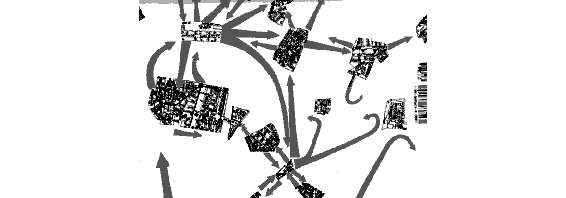Cybernetics: (derives from the Greek word for steersman, which was used by Plato in the sense of "government."):The technology of process control was developed by Norbert Weiner into "the field of control and communication theory (based on statistical information) , whether in the machine or animal" . The terms was first introduced in 1947. See Wiener Cybernetics.
Read Morecybernetic
Cyberscience
Evelyn Fox Keller calls information theory, cybernetics, systems analysis, operations research, and computer science all parts of "cyberscience."
Read Morefeedback
In all feedback systems, some portion of the output system is used as input. Positive feedback adds the output to the input, leading to "vicious cycles." Negative feedback is self-regulating, inducing the system to approach equilibrium or steady-state. (In communications engineering, these two modes are also called regenerative and degenerative cycles.)
Read Morehypertext

In the July, 1945 issue of The Atlantic Monthly, Vannevar Bush, who had served as the first director of the Office of Scientific Research and Development, the agency established by Roosevelt to coordinate federally funded defense research, published an article entitled "As We May Think." In it, he pointed out the increasing gap between the growing mountain of research and the inadequacies of methods for transmitting and reviewing its results, which he blamed in part on the artificiality of systems of indexing. He suggested that the human mind operates by association. "With one item in its grasp, it snaps instantly to the next that is suggested by the association of thoughts, in accordance with some intricate web of trails carried by the cells of the brain." He proposed "a mechanized, enlarged, and intimate supplement to an individual's memory, a future device" which he called a "memex" using electro-mechanical technology as a device for associative indexing, a reading and writing machine that would allow "wholly new forms of encyclopedias to appear, with a mesh of mesh of associative trails running through them." Users would create "endless trails" of links...exactly as if the physical items had been gathered together from widely separated sources and bound together to form a new book."
Read Morenon-linearity
In dynamical terms, such as in the study of chaos, a non-linear situtation is one where the result is not proportional to the cause. For instance "the straw that broke the camel's back" (eg. the elastic/plastic limit in building structures) introduces non-linearity. Up until that point, deformation had been proportional to load. Suddenly it loses all proportionality.
Read MoreProprioceptive: sense
The proprioceptive sense informs us about the position of our own limbs in relation to one another and to the space around us. Its sensations come from the muscles and tendons and are not localized. The proprioceptive and tactile sensations combine to constitute the haptic. Proprioceptive feedback is an important developmental component in the sense of agency.
schismogenesis
Gregory Bateson uses this term to describe progressive differentiation between social groups or individuals. For example, if two groups exhibit symmetrical behaviour patterns towards each other that are different from the patterns they exhibit within their respective groups, they can set up a feedback , or "vicious cycle" relation. For example, if boasting is the way they deal with the other group, and if the other group replies to boasting with more boasting, then each group will drive the other into excessive emphasis on the pattern, leading to more extreme rivalry, and ultimately to hostility and the breakdown of the system. (Steps towards an Ecology of Mind, p. 68) An arms race is another symmetrical form of schismogenesis.
teleology
In the Timaeus, Plato pictured the natural world as the product of a divine craftsman who looked to the world of eternal being for his model of the good and then created a natural order that was as good as it possibly could be. ("Teleology", by James C. Lennox, in Keller and Lloyd, eds. Keywords in Evolutionary Biology ) This model is the origin of what is sometimes referred to as "external teleology." The "externality" is twofold: the agent whose goal is being acheived is external to the object, and the value is the agent's value, not the object's. (This is much closer to the idea of the machine)
Read More